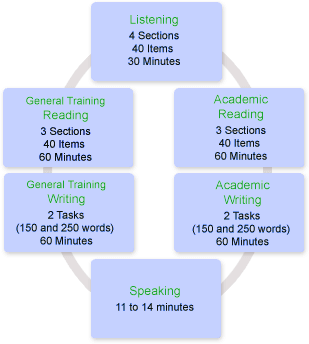IELTS test structure
The IELTS test has four parts:
- Listening: 30 minutes (plus 10 minutes' transfer time)
- Reading: 60 minutes
- Writing: 60 minutes
- Speaking: 11–14 minutes
The test total time is: 2 hours and 45 minutes
Listening, Reading and Writing are completed in one sitting. The Speaking test may be taken on the same day or up to seven days before or after the other tests.
All test takers take the same Listening and Speaking tests, while the Reading and Writing tests differ depending on whether the test taker is taking the Academic or General Training versions of the test.
Listening
The module comprises four sections, with ten questions in each section. It takes 40 minutes: 30 - for testing, plus 10 for transferring the answers to an answer sheet.
Sections 1 and 2 are about everyday, social situations.
- Section 1 has a conversation between two speakers (for example, a conversation about travel arrangements)
- Section 2 has one person speaking (for example, a speech about local facilities).
Sections 3 and 4 are about educational and training situations
- Section 3 is a conversation between two main speakers (for example, a discussion between two university students, perhaps guided by a tutor)
- Section 4 has one person speaking about an academic subject.
Each section begins with a short introduction telling the test taker about the situation and the speakers. Then they have some time to look through the questions. The questions are in the same order as the information in the recording, so the answer to the first question will be before the answer to the second question, and so on. The first three sections have a break in the middle allowing test takers to look at the remaining questions. Each section is heard only once.
At the end of the test students are given 10 minutes to transfer their answers to an answer sheet. Test takers will lose marks for incorrect spelling and grammar.
Reading
The Reading paper has three sections and texts totaling 2,150-2,750 words. There will be a variety of question types, such as multiple choice, short-answer questions, identifying information, identifying writer’s views, labeling diagrams, completing a summary using words taken from the text and matching information/headings/features in the text/sentence endings. Test takers should be careful when writing down their answers as they will lose marks for incorrect spelling and grammar.
Texts in IELTS Academic
- Three reading texts, which come from books, journals, magazines, newspapers and online resources written for non-specialist audiences. All the topics are of general interest to students at undergraduate or postgraduate level.
Texts in IELTS General Training
- Section 1 contains two or three short texts or several shorter texts, which deal with everyday topics. For example, timetables or notices – things a person would need to understand when living in an English-speaking country.
- Section 2 contains two texts, which deal with work. For example, job descriptions, contracts, training materials.
- Section 3 contains one long text about a topic of general interest. The text is generally descriptive, longer and more complex that the texts in Sections 1 and 2. The text will be taken from a newspaper, magazine, book or online resource.
Writing
The Writing paper has two tasks which must both be completed. In task 1 test takers write at least 150 words in about 20 minutes. In task 2 test takers write at least 250 words in about 40 minutes. Test takers will be penalised if their answer is too short or does not relate to the topic. Answers should be written in full sentences (test takers must not use notes or bullet points).
IELTS Academic
- Task 1: test takers describe a graph, table, chart or diagram in their own words.
- Task 2: test takers discuss a point of view, argument or problem. Depending on the task, test takers may be required to present a solution to a problem, present and justify an opinion, compare and contrast evidence, opinions and implications, and evaluate and challenge ideas, evidence or an argument.
IELTS General Training
- Task 1: test takers write a letter in response to a given everyday situation. For example, writing to an accommodation officer about problems with your accommodation, writing to a new employer about problems managing your time, writing to a local newspaper about a plan to develop a local airport.
- Task 2: test takers write an essay about a topic of general interests. For example, whether smoking should be banned in public places, whether children’s leisure activities should be educational, how environmental problems can be solved.
Speaking
The speaking test is a face-to-face interview between the test taker and an examiner.
The speaking test contains three sections.
- Section 1: introduction and interview (4–5 minutes). Test takers may be asked about their home, family, work, studies, hobbies, interests, reasons for taking IELTS exam as well as other general topics such as clothing, free time, computers and the internet.
- Section 2: long turn (3–4 minutes). Test takers are given a task card about a particular topic. Test takers have one minute to prepare to talk about this topic. The task card states the points that should be included in the talk and one aspect of the topic which must be explained during the talk. Test takers are then expected to talk about the topic for 2 minutes, after which the examiner may ask one or two questions.
- Section 3: discussions (4–5 minutes). The third section involves a discussion between the examiner and the test taker, generally on questions relating to the theme which they have already spoken about in Section 2.


